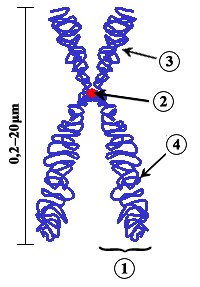File:Chromosome-upright.png
Jump to navigation
Jump to search
Chromosome-upright.png (200 × 287 pixels, file size: 7 KB, MIME type: image/png)
File history
Click on a date/time to view the file as it appeared at that time.
| Date/Time | Thumbnail | Dimensions | User | Comment | |
|---|---|---|---|---|---|
| current | 14:48, 7 March 2007 |  | 200 × 287 (7 KB) | Dietzel65 | {{Information| |Description= {{en|Scheme of a Chromosome. (1) Chromatid. One of the two identical parts of the chromosome after S phase. (2) Centromere. The point where the two chromatids touch, and where the microtubules attach. (3) Short arm (4) Long ar |
File usage
The following 2 pages use this file:
Global file usage
The following other wikis use this file:
- Usage on af.wikipedia.org
- Usage on ar.wikipedia.org
- Usage on ca.wikipedia.org
- Usage on de.wikipedia.org
- Usage on en.wikipedia.org
- User:Iothiania
- Chromosome regions
- User:LaurenCole
- User:Jstupple7
- User:Da Big Bozz
- User:CzechOut
- User:Cory Kohn
- User:Nuigurumi
- User:Kantokano
- User:Andieness
- Wikipedia:Userboxes/Science
- User:Porsche997SBS/Userboxes
- User:Wlodzimierz
- User:Porsche997SBS/Userboxes/User Mendizzle
- User:StonedChipmunk/Userboxes
- User:Mezza1234
- User:Feirith
- User:Anat
- User:Suavesana
- User:Dr. Hannibal Lecter
- User:Jvbishop
- User:Deepti A
- User:Gailbear
- User:LobsterTentacles
- User:GenghisTheHun
- User:Squall1991
- User:Pastel kitten
- User:Doug709
- User:EuPhyte
- User:EyeOfNewt
- User:Shortplaya
- User:Scienza
- User:Till D.
- User:Sudoku424
- User:Proud Muslim
- Template:User Biotechnology and Genetics
- User:Q Original
- User:UC'tCM!/'
- User:MOTHER4
- User:Shermoo
- User:Hawkeyegirl
- User:ReluctantPhilosopher
- User:Skittleys/userboxes
- User:Yamaka122/Userboxes
- User:Yamaka122/newboxes
View more global usage of this file.




